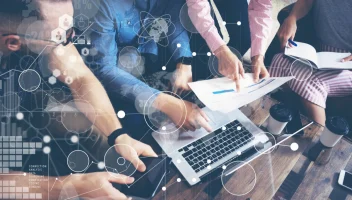Uitgelicht in deze blog
Aptean’s Food and Beverage 2021 Global Symposium – D.I.S.H. Discussion Panel Session Recap
Aptean’s Food and Beverage 2021 Global Symposium – D.I.S.H. Discussion Panel Session Recap
21 Okt 2021
John McCurdy
Continuing with our ongoing blog series covering the sessions of Aptean’s Food and Beverage 2021 Global Symposium, we’ve collected some of the key insights from our D.I.S.H. Discussion panel session entitled “Perspectives on Technology and Innovation in the Food and Beverage Industry.”
Hosted by Jack Payne, director of solutions consulting for food and beverage at Aptean, the conversation centered on the day’s themes of data, innovation, sustainability and humanity (thus the D.I.S.H. acronym) and offered a chance to hear from multiple thought leaders in the industry. The discussion began with an introduction for each of the participants:
Bethan Grylls, Editor of New Food Magazine
With a background in writing and passion for both the arts as well as food and beverage, Grylls joined New Food magazine in 2019 as editor and has strengthened the publication’s position among the leading sources of industry news and thought leadership. As part of her role, she helped to organize the world’s largest scientific food and beverage conference this year—an event entitled Food Integrity 2021—where traceability was a hot topic.
“The sector’s doing a lot of great work, but there’s still a long way to go,” Grylls said. “There’s a lot of pressure put on the industry and the government, but also on the consumers. One of the biggest problems we have on this front is food waste, and a lot of that happens in the home. It’s one of the most significant factors in climate change.”
Eric Kimberling, CEO & Founder of Third Stage Consulting
Kimberling, who is known as one of the most trusted and completely neutral consultants on technology in food and beverage, is also well-regarded as a speaker and author, with numerous articles published in various outlets and a new book, Lessons from 1,000 Digital Transformations. He’s known for helping clients with business integrations and process re-engineering.
“The most important thing is to address organizational change management,” Kimberling said. “Make sure that you have a clear change strategy that is unique to who you are as an organization, what your culture is and what you’re trying to be. You have that clear change plan that goes well beyond training and communication.”
Krista Garver, Editor in Chief at Food Industry Executive
Garver became involved with the food and beverage industry in 2013, when she founded The Growth Co., a content-focused digital marketing agency, and started working with a food trade association. Then, in 2016, she helped establish Food Industry Executive as a digital hub for food and beverage organizations, covering news and trending topics while also providing resources including a supplier catalog. In college, she obtained her bachelor’s degree in psychology and cognitive science, and that is what eventually led to her discovering her passion for publishing and communication.
“While I enjoyed doing the experiments while working in labs, what I really loved was helping to write the papers,” Garver said. “This was at a time when science had a reputation for being very opaque. I really love the process of turning highly specialized and very technical information into something that could be easily understood.”
Engaging in the D.I.S.H. Discussion
Q: What do you think are the most effective ways a food and beverage business can transition from simply collecting information and generating reports to actually finding data-driven insights, and what areas of operations are impacted the most by these efforts?
Eric Kimberling: Data is often an overlooked component, but it’s becoming an increasingly important part of ERP implementations. The general things you can do to move from simple data collection and reporting to more of an analytical, decision-making framework is to make sure that the data you have is accurate. It’s amazing how many organizations have corrupt data either because they didn’t load it into their systems in the right way or the human interactions and broken processes along the way have somehow corrupted it.
The second step is a combination of technological and cultural, and that’s looking at ways that you can leverage predictive analytics, machine learning or artificial intelligence. These are ways to take data and not simply look in the rear-view mirror and see what’s happened in the past, but more importantly look at what could be happening—or what should be happening—in the future based on trends and other correlations.
You need the right technology and software to help you do all that, but it’s also a mindset shift. Instead of looking to the past, you’re looking to the future and trying to predict what might happen with customer demand or how your product mix might change, where supply chain bottlenecks might emerge. So those are some of the ways you can be using that data.
The area that is most ripe for benefit or gain from having a clear data strategy would be on the regulatory side, providing lot traceability and being able to track where in the supply chain there might be a quality issue, shortage or raw material disruption. You’ll have better visibility into your supply chain, and also better efficiency in the way you plan your production so that you’re producing the right things at the right time.
Q: How would you advise someone to transition to looking at what’s going to happen in the future instead of looking at what happened yesterday?
EK: The first step is to identify the technology that might help you get there and get to the point where you can be looking at your future. If you’re limited by your technology, then it’s all talk until you have the right tool or software.
But possibly more importantly, you need to shift gears and realize that there are going to be role and responsibility changes as a result. You need to identify those if you’re automating part of someone’s job or expecting someone to use data in a different way than they have used it in the past. You can’t just put a tool in front of them and say, ‘Here you go, you can do predictive analytics.’ You have to teach them how their job is changing and what their role should be in the new environment, and then define what their new processes are.
If you’re becoming a more forward-thinking organization, you’re not just looking at reports on past results, you’re looking at how you can improve, optimize and better meet customer demands and provide a better experience.
Krista Garver: Investment in the tools and the talents to really make your data usable is key. Even if a lot of your machines are already collecting data, that doesn’t mean you have information. Data science and data analysis professionals are two of the most in-demand employee profiles right now, and it’s really important to make those investments.
In terms of the areas to be improved upon, one would be dialing in your product offerings based on consumer behavior. Hostess is a great success story on this front—a couple of years ago, they invested in data analytics specifically to better understand and grow their sales in convenience stores. They took what they found, reduced the total number of SKUs and focused on their core products, and they now have a 30% market share in the convenience channel. These investments can pay off quickly and effectively.
The other area is predictive maintenance on equipment. You can use analytics to monitor your equipment, determine your maintenance needs and schedule your maintenance in advance so that you’re not just responding to emergency situations. Roughly 30% of CPG companies are currently evaluating predictive maintenance, about 20% are piloting it, and about 20% have already implemented it. So that’s an area where there’s both a lot of momentum and a lot of opportunity for growth.
Bethan Grylls: If you’re looking to transition, you need to have a clear vision of what you want to achieve. I’d compare it to lab testing, where a lot of tasks are completed simply because they’re required, but the workers don’t really understand why they’re doing it or what the results mean. I think you need to partner with someone who can help you through that transition and not be afraid to ask questions!
So the ‘why’ and what you’re trying to achieve is a great starting point, but when you implement a new technology, other things come to light as well. That makes it a journey, not a race—you have to take your time and figure out where it is that you have constraints currently.
There are so many advantages that come with transitioning to a smart factory setup. By implementing intelligent systems, companies can foresee trends, reduce human error and allow your workers to work on more meaningful and, arguably, more enjoyable jobs.
It can also help us meet sustainability targets. I know that Hellman’s uses an excellent technology that allows them to monitor how much waste they’re creating via a scale and camera setup. It shows them what they’re throwing away and identifies trends to see where waste is occurring so that data-driven action can be taken.
Q: Innovation is one of the key trends in the food industry. We’re also seeing innovation from the FDA as they announce their vision for smarter food safety and traceability not just across a company but across the complete supply chain from farm to fork. What can you share with us on this topic?
KG: There is some really interesting innovation going on in the traceability space. One of the things that’s going to be huge—it already is, actually, but it will continue to grow—is the importance and usability of blockchain technology across the supply chain. It provides a complete chain of custody in real time, and because no one person owns the data, it can’t be tampered with.
Walmart now uses blockchain technology—they actually adopted it in 2018 after some major issues of E. coli in romaine lettuce. They didn’t know what bag of salad came from where, and so much food had to be thrown away, exacerbating the waste problem.
At that time, Walmart said that with their old paper-based systems, it took them about a week to track down where the products had come from. Today, they track more than 500 products with blockchain, and they can trace back to origin in seconds. So it’s very, very powerful.
In terms of emerging technologies, there are a lot of fun things happening. Just a few weeks ago, the FDA announced the 12 winners of their Low- or No-Cost Tech-Enabled Traceability Challenge. If you haven’t seen them yet, I highly recommend you go check it out—there are short videos for each of them.
One of the coolest ones among them I got to see live last week, from a company called Wiliot. They’ve developed what they call Wiliot Pixels. They’re these little tiny stickers, just about an inch square, but they’re actually tiny computers with sensors. You can attach them to food packaging, crates or pallets—anything you want to trace—and they can collect a large amount of data, including location, temperature and humidity. It’s really a very powerful little chip, and it relays the data to the cloud using Bluetooth.
Then, the Wiliot Cloud uses software that turns that data into insights and actually uses machine learning algorithms to identify trends and adjust over time. The company is now licensing them and giving away the stickers for free. You pay for the software, but they’re keeping it a very accessible and low-cost way to manage traceability.
BG: I agree that blockchain is the big thing to watch. It can take traceability systems to another level, from offering detailed reports on any product, its status and movements and creating direct links between the various stakeholders along the supply chain. I mentioned earlier total or ‘radical’ transparency, and as we start to see that happen and consumers start to demand more complete traceability of products, we’ll start to see more brands implement blockchain.
There are other ways companies can achieve that transparency, too. There’s a beverage brand that uses QR scanners, and you can get complete details on the entire journey as far as where your beverage came from, which is fantastic. It’s great, because it’s going to give the consumer much more reassurance.
We’re going to be moving from reactive to preventative measures, analyzing what’s happening and predicting errors before they happen. Now we’ll be able to detect food issues and prevent recalls from having to be issued, or at least limit recalls by pinpointing the product that is dangerous rather than recalling all of the stock, which would be quite wasteful if some of it is perfectly safe.
EK: Another even more fundamental technology I’d mention is the smart factory concept or Industry 4.0, really automating as much of the supply chain as possible from suppliers to customers and everywhere in-between. The sooner organizations can move to that smart factory or Industry 4.0 concept, the sooner they’ll be able to leverage these emerging technologies that Krista and Beth have talked about.
For a lot of organizations, it’s such a big jump that they don’t really know how to get to that end-state. I feel like there’s an incremental step those companies can be taking to get that foundation in place so that as these newer technologies mature, become more common and have more use cases, they’re in the position to take advantage of them because they’ve automated more of their supply chain and factory while collecting data along the way.
Q: Sustainability is no doubt a major topic. What does the concept mean to the food industry, and what are food companies doing to try to contribute to sustainability?
BG: For me, being sustainable means meeting our own needs without compromising future generations. So if you’re a sustainable business, you’re one that considers these three areas. Businesses that are sustainable are serious about making meaningful commitments to low-carbon solutions, promoting sustainable patterns of production and consumption and embedding sustainable sourcing within their supply chains.
A lot of companies are doing a good job of reducing their own waste, but 60% of all food waste occurs in the home. So how do you control something when it’s not happening within your plant? One answer there is you educate and you inform.
The same goes for your supply chain. A lot of companies are helping farmers to understand sustainable practices and helping them implement them. Taking coffee for example, that’s a resource-intensive growing process, as it requires a lot of water. Nespresso has helped to build shared water mills in the communities it sources from. They realize that where you make an impact, you have to offset it. The company recently announced that every cup of its coffee will be carbon-neutral by 2022, and they’ve already achieved carbon neutrality within business operations.
I’ll also mention biodiversity, as that’s one of the things that gets forgotten. Just to give you an idea, a typical consumer’s menu comes from 12 crops and 5 animal species. But there are over 20,000 edible plant species worldwide. A really great example is Unilever—they launched their 50 Future Foods project, basically listing 50 foods that we don’t typically use and how to cook them. That’s a really brilliant initiative.
EK: If a company is vertically integrated, they can have greater control over their own actions on the sustainability front. But for food and beverage companies that aren’t vertically integrated that rely heavily on suppliers, they have supplier scorecards that allow you to rate the procurement you’re doing.
In the past, you might have rated a supplier on quality, cost, speed of delivery, etc. Now you can add new dimensions around sustainability. Businesses can ask, is this supplier someone that aligns with our vision of how sustainable we want to be? And they can answer that based on the angle they choose, whether it’s the carbon footprint, biodiversity, whatever the case may be.
KG: We’ve really come to a place where the idea of sustainability is so much more than just climate change or just carbon footprint. I was speaking with someone from Deloitte earlier this year about how attitudes toward sustainability have changed, and what she said was that sustainability has always been important, but it hasn’t been funded. Now, companies have to put their money where their commitments are—they can’t just push things into the future.
Especially when younger consumers are going to the store, they’re educating themselves about companies’ sustainability efforts. They’re also interested in sustainability efforts when they’re choosing where they want to work. So companies that take a broader approach to sustainability, accounting for environment, economy, people and equity, those are the ones that are going to succeed.
More on Aptean and Global Symposium
Aptean provides purpose-built, industry-specific solutions that food and beverage businesses leverage as the foundation for their digital transformations. With Aptean's food ERP, an organization can make full use of their data, optimize operations and make real progress on sustainability goals.
If you’d like to hear more about what our systems can do for your food and beverage company, contact us today.
Also be sure to check back for more of our session recaps, and browse our Insights page for those we’ve published previously. And if you’d like to view any of our sessions on-demand, you can do so here.
Related Content





Wilt u weten wat we voor uw voedingsbedrijf kunnen betekenen?
Wij helpen u graag. Neem contact met ons op en ontdek welke smaken we te bieden hebben.



